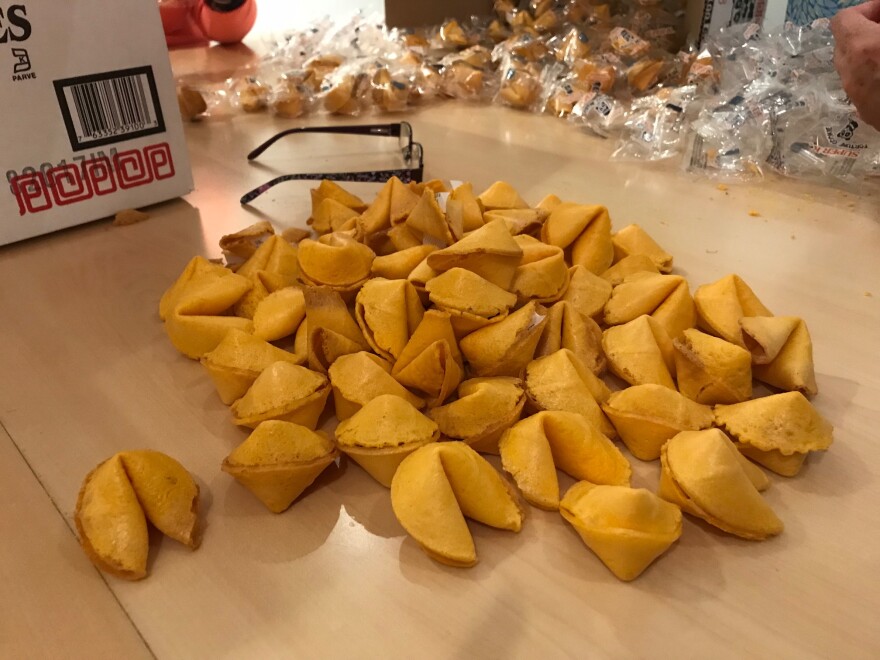The fortune cookie is a beloved tradition associated with Chinese restaurants -- even though it’s a custom born in the U.S.
“I remember as a kid always looking forward to digging in the bag to get the fortune cookie because there’s something neat about having to break something open, take out a tiny piece of paper and see what it says,” said Jess Killingsworth, marketing coordinator for the Loveland Art Museum.
Killingsworth has been thinking a lot about fortune cookies lately. In a maze of rooms in the museum’s office space are hundreds of boxes lined up along the walls, stacked almost to the ceiling. Printed both in English and in Chinese next to a cartoon panda, the boxes announce their contents: “Fortune Cookies.”
“It’s not every day that you’re going to be able to come to an exhibit at the museum here in Loveland and see an art installation in the middle of the room that is made from 250,000 fortune cookies,” she joked.
The cookies will be part of Chinese-born, California-based artist Hung Liu’s Colorado debut. “Jiu Jin Shan,” Chinese for “Old Gold Mountain,” will feature four lengths of railroad tracks all leading to a gigantic mound of fortune cookies in the center. It’s a commentary on the American Dream and the role of Chinese immigrants in that dream, specifically during the 1800s when they were the labor behind the first Transcontinental Railroad.

But getting the installation ready required some help on the part of the museum, including obtaining 250,000 unwrapped fortune cookies. Sounds simple, right? Not so fast.
“They do manufacture them unwrapped, but they are almost double to triple the cost,” said Killingsworth, who declined to say how much the final cost for the cookies actually was. “So that’s why we decided to purchase them wrapped and just decided to unwrap them ourselves.”

But with the museum’s staff at just under a dozen employees, unwrapping 250,000 fortune cookies in just over four weeks seemed an enormous task. That’s when the museum’s volunteers stepped in.
The repetitiveness of the work is familiar to Kay Saelens. She used to work the assembly line at the Green Giant canning plant in Belvidere, Illinois. The 79-year-old volunteers at the museum as a docent -- and now cookie un-wrapper.
To make the time pass faster, Saelens and the four other volunteers on duty chatted, ate the occasional broken cookie and read their fortunes aloud.
“I belong to a singles group and we used to read the fortune cookies after we were at a meal at a Chinese restaurant and then if you add the words ‘in bed’ at the end of the fortune cookie, it can be rather hilarious,” Saelens said before reading one.
“You are known for being quick in action and decisions -- in bed,” she chuckled.
Soon, everyone was sharing their fortunes and their versions of the game.
“You have an uncanny willingness and ability to help others -- in the bedroom,” read Karin Bierstein, 63.
“Who has confidence in himself will gain the confidence of others -- between the sheets,” countered Beirstein’s friend, Nancy Garcia.

Garcia, 67, is also a docent at the museum. She said she loves the idea of taking part -- even if it’s just a small one -- in the artistic process.
“I think art should kind of blow your mind and expand your consciousness and be different and the visual is just so interesting,” she said. “This mountain of cookies -- I can see it in my mind. I can’t wait to see on the floor.”
Time is of the essence. All of the cookies need to be unwrapped in time for the December 8th opening of Hung Liu’s exhibit, “Transformation.” While they still have a ways to go, Garcia has her eye on the show’s closing.
“The mystery for me is what’s going to happen to them after the exhibit,” she said. “I’m very big on recycling, repurposing, reusing so I’m just really hoping we can find a good use for these 700 boxes of cookies.”

Museum officials are still working on that one. One of the options they’re talking about is donating them to a wildlife refuge in need of high-caloric foods to help prepare the animals for hibernation.
In the meantime, Killingsworth said the project has been a fun way to bring people together, much like fortune cookies themselves.
“A lot of people keep those fortunes -- I have some in my wallet right now,” she said. “Whether you believe that that little piece of paper brings you good fortune or not, it’s a nice sentiment to think about. It can make you smile, it can make you laugh, it can make you hold onto it. Anything in this day and age that can do that, we need to continue on.”






